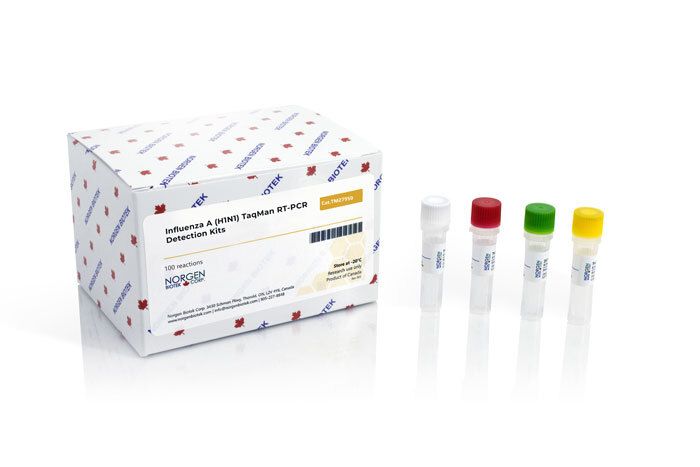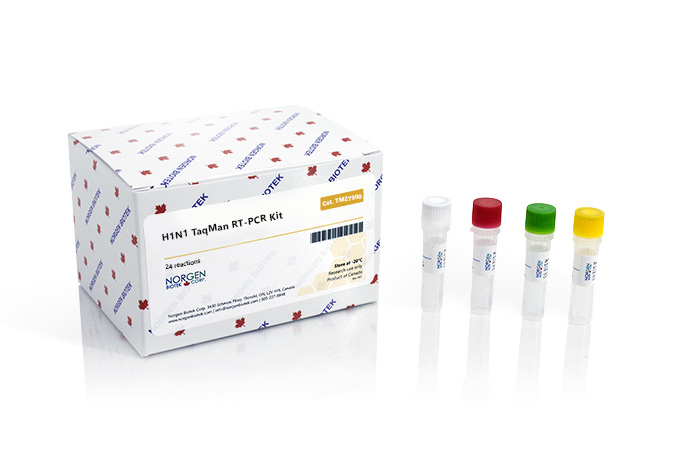Influenza A (H1N1) TaqMan RT-PCR Detection Kits

For research use only and NOT intended for in vitro diagnostics.
Influenza A (H1N1) TaqMan RT-PCR Detection Kits
Register today to receive an exclusive 15% off* on your first order.
Features and Benefits
- Detection kits for H1N1
- CE-IVD marked version available for in vitro diagnostic use
- Available in TaqMan format for analysis
Influenza is caused by three immunologic types of RNA viruses (A, B and C) within the Orthomyxoviridae family. Seasonal influenza is typically caused by three major subtypes of hemaglutinin (H1, H2 and H3) and two subtypes of neuraminidase (N1 and N2). A novel sub-type of influenza A virus called pandemic H1N1 2009 virus was identified in Mexico and reported by the CDC and WHO in April, 2009 (Novel swine-origin influenza A (H1N1) virus investigation team, 2009; CDC, 2009; and Fraser et al., 2009). H1N1 2009 is a novel sub-type virus that transmits easily between humans with 21 countries reporting cases within a month of initial identification (CDC, 2009-b). It is essential that public health laboratories around the world undertake detailed surveillance to monitor the spread and impact of pandemic H1N1 2009 virus as well as try to predict future changes in virulence (Fraser et al., 2009). Methods for the rapid diagnosis, case identification and tracking of this novel pathogen in the human population are therefore required to develop appropriate management strategies to mitigate morbidity and mortality.
Click to expand options
- Ready to use format, including Master Mix for the target and PCR control to monitor for PCR inhibition and validate the quality
- Specific Primer and Probe mix for the pathogen/virus/viroid of interest
- Primer and Probe mix
- Positive and negative control to confirm the integrity of the kit reagents
- Specific Primer/Probe mix and Positive Control for the pathogen/virus/viroid of interest
- Nuclease-free water
- Can be used together with Norgen’s RT-PCR Master Mix (#28113) or customer supplied master mix
Details
Supporting Data
TaqMan PCR Kit - Figure 1. Example of TaqMan One-step RT-PCR Positive result. Both PCR signals above the baseline from FAM and HEX channel indicate the successful PCR.
TaqMan PCR Kit - Figure 2. Example of TaqMan One-step RT-PCR Negative result. No target RNA was detected in FAM channel but amplification signal from HEX indicates the successful PCR.
TaqMan PCR Kit - Figure 3. Example of TaqMan one-step RT-PCR inhibition result. No signal from both FAM and HEX channel was detected. It is suggested to repeat the sample preparation using recommended kit for RNA purification.
Storage Conditions and Product Stability
All kit components can be stored for 1 year after the date of production without showing any reduction in performance.
All kit components should be stored at -20°C upon arrival. Repeated thawing and freezing (> 2 x) of the Master Mix and Positive Control should be avoided, as this may affect the performance of the assay. If the reagents are to be used only intermittently, they should be frozen in aliquots.
| Component | Cat. TM27950 (100 preps) | Cat. TM27910 (100 rxns) |
|---|---|---|
| MDx TaqMan 2X RT-PCR Master Mix | 2 x 700 μL | - |
| H1N1 Primer & Probe Mix | 280 μL | 280 μL |
| H1N1 Positive Control | 150 μL | 3 x 50 μL |
| Nuclease-Free Water (Negative Control) | 1.25 mL | 1.25 mL |
| Product Insert | 1 | 1 |

